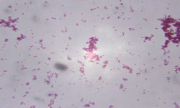Pathogen and transmission
Gonorrhoea, colloquially known as the clap, is one of the most widespread sexually transmitted infections worldwide. It is triggered by the bacterium Neisseria gonorrhoeae, which can be found in the mucous discharge of infected persons and is transmitted through unprotected oral, vaginal or anal intercourse as well as from the mother to the child during birth.
Clinical picture
After an infection, the first symptoms usually appear within two to seven days. In men the initial symptoms are reddening and swelling of the urethral orifice, with pain during urination and purulent discharge. Left untreated, the infection encroaches on the prostate and epididymis. In women, the infection also mostly manifests through increased discharge and pain during urination; without treatment the infection may spread throughout the pelvis.
However, the infection is often (more so for women than for men) asymptomatic or develops with only mild symptoms and thus goes undetected for some time. Depending on the sexual practice, the symptoms can also appear in the mouth or throat as well as in the anal region - often asymptomatically or as reddening and irritation. A course of antibiotics provides a cure. However, there are disturbing reports of strains that are resistant to antibiotics that were successfully used to treat the disease up to a few years ago.
A long-term effect of untreated gonorrhoea in both sexes is sterility. Less frequent complications include inflammations of the joints, skin, heart and conjunctiva - the latter also in case of transmission during birth.
Frequency and distribution
In Switzerland, as in the rest of Europe, the number of gonorrhoea infections reported each year is steadily increasing. In 2022, there were 5,112 confirmed cases of gonorrhoea in Switzerland, around 25 percent more than the previous year. However, this is mainly due to increased testing in the risk groups. Men account for a very high 80 percent of diagnosed cases, and the 25-34 age group is particularly at risk. Homosexual and bisexual men, persons with multiple sexual partners and sex workers exhibit a higher incidence of infection than the rest of the population.
Prevention
Using a condom reduces the risk of syphilis infection. But you can still get infected even if a condom is used. What’s important is to identify this and get appropriate treatment as swiftly as possible.
So: If you have changing or multiple sexual partners during the same time period, talk to your doctor or another specialist about gonorrhea and other sexually transmitted infections and get advice on whether you may need to be tested.
If you are found to have an infection, you’ll find useful guidance and tips on our www.lovelife.ch website on how to inform your partner(s).
And for everyone having sex:
Do your Safer Sex Check at www.lovelife.ch!
If you’re pregnant, be sure to have regular check-ups with your gynaecologist, too. Pregnant women are tested for HIV, syphilis, hepatitis B and more to help protect the unborn child.


